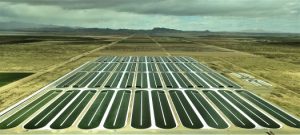Algae as a Source of Biofuel
- Biofuels is renewable energy resources which can be produced from living organisms or metabolic byproducts.
- Biomass-based fuels are utilized by over half of the Earth’s population like firewood or agricultural materials for cooking and heating purposes.
- It is an appreciable alternative to fossil fuels fulfilling the growing needs of the population
- Algae as biofuel feedstock might eradicate the economic and environmental challenges which are a major problem in current terrestrial biomass feedstock.
- These are suitable for biodiesel and bioethanol production because o their quick growth, excellent biomass yield, and high lipid and carbohydrate contents.

Biofuel
Bio-Diesel
- With the increasing population, expanding economy, extensive use of fossil fuel, global climatic change and increasing greenhouse gas emissions have become a matter of concern over the decades
- Biodiesel is defined as the monoalkyl esters of vegetable oil and animal fats.
- Biodiesel is especially produced by the transesterification of triglyceride with monohydric alcohols like methanol
- Biodiesel is majorly produced from vegetable oil including soybean, palm and sunflower oil followed by biomass-based and non-agricultural feedstocks.
- Microalgae is the most effective biofuel producer. It is required for the rapid growth of carbon-neutral renewable alternatives due to its potential commercial feasibility.
- Microalgae capture solar power or energy as they are sunlight-driven cell factories that convert greenhouse emission (CO2) to potential biofuel, food, feeds and bioactive compounds
- Microalgae limit the competition for resources with conventional agriculture and might be grown in numerous types of water sources including marine, brackish, or freshwater, utilizing raceway ponds on non-arable land.
- The main steps for microalgal based biodiesel production in a biorefinery involves:-
- Selection of Microalgae – Microalgae selection is targeted on three predominant selection criteria: (1) water type; marine, brackish, and freshwater. (2) cultivation strategy; uni or mixed cultures. (3) Natural or genetically modified cultivars. However, the choice of microalgae for the formation of algae-based biodiesel is solely based on the concentration of lipids, productivity, and its harvest potential.
- Cultivation and Recovery of Microalgal Biomass – There are two fundamental methods for microalgae cultivation: (1) open pond systems and (2) closed photobioreactor systems. Open pond systems normally include raceways ponds, lagoons, and/or troughs; whereas closed systems include various kinds of photobioreactors i.e. tubular, flat or columnar etc. The recovery of microalgal biomass is a major step for biodiesel feedstock production. As microalgae contain more than 99 % water (w/w) so dewatering is one amongst the foremost important steps in biodiesel production from algae which is finally finished by filtration or other methods.
- Enhancement in Quantity and Quality of Microalgae – Microalgae can grow rapidly and live in harsh conditions because of their simple unicellular or multicellular structure. Growth rates can be increased immensely through heedful species selection and culture conditions
- Disruption of Microalgal Biomass – Cell wall disruption methods include: osmotic shock, explosive decompression, mechanical press, mechanical shear etc.
- Oil Extraction- Once the cell is ruptured, the lipid fraction, consisting of fatty acids and glycerol, are separated from the remaining cell contents.
Bioethanol
- Bioethanol serves as a great alternative to fossil fuels. Its use has been seen in transportation fuel.
- It includes a depletion in particulate, nitrogen oxides and carcinogens such as benzene, toluene, ethylbenzene and xylene.
- The bioethanol is sustainable due to the CO2 emission by combustion which can be mostly fixed by the growing plants through photosynthesis
- Bioethanol is manufactured from various feedstocks i.e. sugarcane, corn, cereal grains, potato, sweet potato, cassava.
- Macroalgae is made up of rigid cellulose-based cell walls that aggregate various complex polysaccharides, which can be hydrolyzed into sugars and eventually be fermented to ethanol.
- But using macroalgae directly for biofuel production will neither be cost-effective nor practical because macroalgae also contain other valuable phycocolloids and bioactive compounds which can be a source for revenue. So new technologies are subsequently used for production.
- The process involved in the biorefinery approach are as follows:-
- Selection of Algae- Algal selection depends upon its availability and accessibility. Two classes of polysaccharides are found in macroalgae: (1) Structural polysaccharides which consist of mainly cellulose, hemicellulose and xylans. (2) Storage polysaccharides, i.e. agar, alginate and carrageenan which are not found in other land plants. The algae containing a high concentration of phenolics or other inhibitors of hydrolysis which should not be utilized for bioethanol production
- Collection of Algae – Collection of wild or harvested macroalgae is a coastal activity. Desalination of seaweeds is an important step because it can cause problems during purification and processing.
- Extraction of Phycocolloids- Phycocolloid extraction from algae is a commercial process. The extracted phycocolloids are purified through filtration and centrifugation processes. The processed algal pulp can be dried and used in further process.
- Hydrolysis- Carbohydrates found in whole algae or leftover pulp can be converted to fermentable sugars through three basic methods (1) acid hydrolysis, (2) enzymatic hydrolysis, or (3) thermochemical. Algal carbohydrates can also be catalysed by endocellulases, exocellulase and β-glucosidase and occur both under aerobic and anaerobic conditions.
- Fermentation- Fermentation is the conversion of carbohydrate into acid or alcohol. Fermentation includes upstream processing of sugar solution and downstream processing of the fermented product. Downstream processing includes separation and purification of ethanol usually by distillation.
References
- https://www.ncbi.nlm.nih.gov/pmc/articles/PMC3152439/
- https://www.ncbi.nlm.nih.gov/pmc/articles/PMC5449280/
- https://mafiadoc.com/dinabandhu-sahoo-joseph-seckbach-editors_5a14b6541723dd3d9fd9a861.html
